Struck

“I had been my whole life a bell, and never knew it until at that moment I was lifted and struck."

“I had been my whole life a bell, and never knew it until at that moment I was lifted and struck."
You Suspect This Could Be Yours
by Rumi, translated by Daniel Liebert
you suspect this could be yours
with a little contrivance
only death to contrivance
will avail you
something good or bad
always comes out of you
it is agony to be still;
the spool turns
when mind pulls the thread
let the water settle;
you will see moon and stars
mirrored in your being
when the kettle boils
fire is revealed
when the millstone turns
the river shows its power
put the lid on the kettle
and be filled
with the boiling of love.
“When you ask people about love, they tell you about heartbreak. When you ask people about belonging, they’ll tell you their most excruciating experiences of being excluded. And when you ask people about connection, the stories they told me were about disconnection.”
~ Brené Brown, from “The Power of Vulnerability” TED Talks, June 2010
Posted by
Daron
at
12:41 PM
![]()
Labels: addiction, belonging, Brené Brown, connection, discomfort, equanimity, numbing, parenting, perfectionism, TED, uncertainty, vulnerability
Dr. Richard Fratianne, from “Art and Medicine,” produced by Kerrie Hillman, Studio 360, December 10, 2010:
The problem is music therapy is not compensated by either governmental programs or private insurance policies, because there just isn't very much science in music therapy — yet. And so, I thought that it might be interesting to see if we could prove the value of music therapy in the burn center where pain and anxiety are really very, very high.
 A burn injury is so profound that it effects every part of the person. It's not only physical and emotional, but it's an intellectual challenge and there's a spiritual threat because patients don't recognize who they are anymore. They don't feel the same. They don't look the same. Oftentimes they feel ashamed of how they look and they're so afraid. We chose burn patients because the pain is so severe and the anxiety is so high that we thought if we can prove that music therapy can actually have a positive effect in these patients, then we can rest assured that it's going to work in every patient.
A burn injury is so profound that it effects every part of the person. It's not only physical and emotional, but it's an intellectual challenge and there's a spiritual threat because patients don't recognize who they are anymore. They don't feel the same. They don't look the same. Oftentimes they feel ashamed of how they look and they're so afraid. We chose burn patients because the pain is so severe and the anxiety is so high that we thought if we can prove that music therapy can actually have a positive effect in these patients, then we can rest assured that it's going to work in every patient.
Obviously, we can give pain medication, we can give sedatives and tranquilizers, but if it's a really painful dressing change there's no way you can relieve all of the pain except under anesthesia and you can't anesthetize a patient two or three times a day. The body won't tolerate it.
Music requires and integration of many parts of the brain. There's the motor part that's the physical response to playing or tapping to the rhythm of music. Then there's the limbic system, the emotional response to hearing music that brings forth feelings and thoughts and ideas. But also there's rhythm, there's tempo, there's melody — all of these things have to be integrated at the same time to appreciate music. It's amazing how the brain can do this.
The reason we need a professional music therapist to intervene in these painful procedures is that by their training they're able to capture the patient's attention. We call that entrainment. It is actively involving the patient in the musical experience. Because when their mind is diverted to participating in the therapy, they cannot think about the pain.
The earlier research just asked the patient before and after a musical experience, “Do you feel better yet?” That doesn’t really prove anything. It’s only when you’re dealing with patients like we’re dealing with in the burn unit that you can clearly identify changes in their response with music therapy. And we have done that.
One of our latest studies is utilizing the measurements of a stress hormone which is one of the products of the adrenal gland in response to stress. We know when patients are highly stressed these levels go up. And we’re measuring to see whether music therapy can actually depress those levels of the hormone. And our initial studies have shown that.
What we’re doing is new. We know that. And that’s why it’s exciting, because it is new. But the music can have a calming effect on people. How it works is still being discovered.
Posted by
Daron
at
8:41 AM
![]()
Labels: anxiety, attention, medicine, music, pain, paying attention, stress, Studio 360
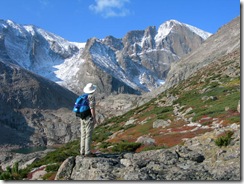 "To make art is to sing with the human voice. To do this you must first learn that the only voice you need is the voice you already have. Art work is ordinary work, but it takes courage to embrace that work, and wisdom to mediate the interplay of art and fear. Sometimes to see your work's rightful place you have to walk to the edge of the precipice and search the deep chasms. You have to see that the universe is not formless and dark throughout, but awaits simply the revealing light of your own mind. Your art does not arrive miraculously from the darkness, but is made uneventfully in the light.
"To make art is to sing with the human voice. To do this you must first learn that the only voice you need is the voice you already have. Art work is ordinary work, but it takes courage to embrace that work, and wisdom to mediate the interplay of art and fear. Sometimes to see your work's rightful place you have to walk to the edge of the precipice and search the deep chasms. You have to see that the universe is not formless and dark throughout, but awaits simply the revealing light of your own mind. Your art does not arrive miraculously from the darkness, but is made uneventfully in the light.
What veteran artists know about each other is that they have engaged the issues that matter to them. What veteran artists share in common is that they have learned how to get on with their work. Simply put, artists learn how to proceed, or they don't. The individual recipe any artist finds for proceeding belongs to that artist alone—it's non-transferable and of little use to others."
~ David Bayles and Ted Orland, from Art & Fear: Observations On the Perils (and Rewards) of Artmaking
[Thanks, Whiskey River!]
 "I never, in any city I've ever been in, never remember the names of streets. The longest place I ever lived in was for five years and I didn't know the name of the next street over. Why bother! I think there's such enjoyment in just getting lost in a city. Having no idea where you are, how you're gonna get out of it. Getting to be the middle of the night, you're still lost, walking around. That's the best way to discover a city. That's how you're born into life. You got no freaking idea which way's up or down."
"I never, in any city I've ever been in, never remember the names of streets. The longest place I ever lived in was for five years and I didn't know the name of the next street over. Why bother! I think there's such enjoyment in just getting lost in a city. Having no idea where you are, how you're gonna get out of it. Getting to be the middle of the night, you're still lost, walking around. That's the best way to discover a city. That's how you're born into life. You got no freaking idea which way's up or down."
~ Christian Bale, in an interview with John H. Richardson for Esquire
See also: The Business from KCRW (December 13, 2010)
Everybody Here is a Cloud
by Cloud Cult
And everybody here is a cloud
and everybody here will evaporate
you came up from the ground
from a million little pieces
have you found where your place is
you've been spending your time
thinking about why you think so much
if there was ever a time
now would be the time to see
your time here is limited
and everybody here is a crowd
we all walk around with a million faces
somebody turn the lights out
there's so much more to see
in our darkest places
everybody here is waiting for the next creation
they say go, go, go, go
* * * * *
Cloud Cult on World Cafe (12/15/2010)
W.S. Merwin from “The Garden & the Sword,” an interview with Joel Whitney, Tricycle Magazine, Winter 2010:
I don’t think we have imagination apart from the environment. And I don’t think we have an existence apart from the environment either. And if the imagination isn’t about our existence, I don’t know what it’s about. It’s not about making money, that’s for sure.
…If you’re looking for neat formulaic answers in Dogen, you don’t find them. You don’t find them in Keizan, either. You have to come at them from a different part of your own mind. That’s the part of Zen practice that’s attractive to me. But it’s not unique to Zen. It’s there in Taoism. It probably was there in parts of the practice that became Greek Orthodoxy, that came out of the desert. The origins of all of those things are extremely ancient; they’re older than what we think of as the beginnings of Buddhism. The origin of Taoism may be completely on its own, but all of them go back to shamanism. And we don’t know know the history of shamanism; it’s all speculation. They link in my mind to things which are incredibly ancient.
…the link between the imagination—which to me is the great pinnacle of humanity, the imagination that makes the arts and makes compassion—is ancient in our species and goes way back. And it’s never been separate. And when you get any aspect of the culture that tries to separate it, it’s destructive and suicidal.
Take them away, names like Buddhism. I’m impatient with them. There’s something beyond all that, beneath all that that they all share, that they all come from. They are branches from a single root. And that’s what one has to pay attention to.
| Song Dynasty painting in the Litang style illustrating the theme "Confucianism, Taoism and Buddhism are one." Depicts Taoist Lu Xiujing (left), official Tao Hongjing (right) and Buddhist monk Huiyuan (center, founder of Pure Land) by the Tiger stream. The stream borders a zone infested by tigers that they just crossed without fear, engrossed as they were in their discussion. Realizing what they just did, they laugh together, hence the name of the picture,Three laughing men by the Tiger stream. |
Posted by
Daron
at
12:57 PM
![]()
Labels: art, Buddhism, compassion, imagination, poets, religion, W. S. Merwin, Zen
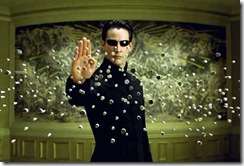 “Hackerdom rewards spontaneity, curiosity and ingenuity. Science rewards rigor and forging solid bedrock to stand on — which means a lot of carefully dotting i’s and crossing t’s. Although scientific questions are harder, more abstract and tend to have less immediate influence in the world, the questions are deeper and the answers so uplifting and transcendently beautiful that contact with them is a genuine spiritual experience.”
“Hackerdom rewards spontaneity, curiosity and ingenuity. Science rewards rigor and forging solid bedrock to stand on — which means a lot of carefully dotting i’s and crossing t’s. Although scientific questions are harder, more abstract and tend to have less immediate influence in the world, the questions are deeper and the answers so uplifting and transcendently beautiful that contact with them is a genuine spiritual experience.”
~ Virgil Griffith, from “Looking for the Real Mark Zuckerberg,” by Virginia Heffernan, New York Times Sunday Magazine, December 12, 2010
Posted by
Daron
at
12:20 PM
![]()
Labels: beauty, science, technology, Virgil Griffith, Virginia Heffernan
"In our modern world that's inundated with media and information, I think the crossword puzzle is a return to asking something of you rather than bombarding you with new information."
~ David Kwong, whose unique performance draws on his talents as a magician and as a crossword puzzle creator.
Excerpt from “Making Joy Our Default Setting,” a Buddhist Geeks conversation with James Baraz (October 18, 2010):
 “If you’re just thinking you’re supposed to be skipping through a meadow in slow motion like a commercial, you’re missing out on what life is about. Truly happy people are not happy all the time. They’re engaged, they’re here for everything through the ups and downs. If you’re going through loss or you’re going through a hard time or you’re outraged about the state of the world, then you’re human. If you don’t go through those things, then you’re probably living in incredible denial…
“If you’re just thinking you’re supposed to be skipping through a meadow in slow motion like a commercial, you’re missing out on what life is about. Truly happy people are not happy all the time. They’re engaged, they’re here for everything through the ups and downs. If you’re going through loss or you’re going through a hard time or you’re outraged about the state of the world, then you’re human. If you don’t go through those things, then you’re probably living in incredible denial…
So, when you’re feeling anger or you’re feeling loss, suppose somebody close to you is sick or dies or you get some scary news or a change of circumstance, to not be afraid to go into them. This is the key, this where you can feel the suffering and hold it with a wise awareness. Where you process it directly and say, ‘Oh, this is what fear is like. This is what anger is like. This is what sadness is like.’ But that which is aware of the sadness is not sad. That which is aware of the fear is not afraid. The awareness can hold it all. So, it’s a matter of really understanding how to work with our sorrows and our fears that really is a path to joy.”
Excerpts from Roundtable: Meeting of the Minds, Tricycle Magazine, Spring 2005:
Richard Davidson: Our initial work certainly indicates that meditation changes brain function. One of our hopes now is that a broader range of scientists will be inspired to examine the potential impact of contemplative practice on different behavioral domains. One of our goals is to launch studies that look at the impact of meditation on attention and the brain systems that support it.
We’ve been talking with experts who do experiments in which, for example, a person is required to focus on a specific object and ignore distractions. One question is whether training in meditation facilitates one’s capacity to do this, and, if it does, which parts of the brain are being affected.
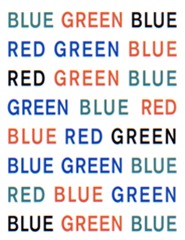 There are well-developed procedures in cognitive psychology for exploring such questions. The classic one is the Stroop Test. In one version of this test, the word “green” might be printed on a card in red, and the subject’s task would be to name the color in which the word was printed (red), ignoring the meaning of the word (green). Classically, people are slower in responding when the color of a word is inconsistent with the name of the word than when the two are the same: when the word “green” is printed in green, people are able to say “green” faster than when they’re looking at the word “green” printed in red. What this requires is that we inhibit our automatic response and focus our attention on the instructions given by the experimenter.
There are well-developed procedures in cognitive psychology for exploring such questions. The classic one is the Stroop Test. In one version of this test, the word “green” might be printed on a card in red, and the subject’s task would be to name the color in which the word was printed (red), ignoring the meaning of the word (green). Classically, people are slower in responding when the color of a word is inconsistent with the name of the word than when the two are the same: when the word “green” is printed in green, people are able to say “green” faster than when they’re looking at the word “green” printed in red. What this requires is that we inhibit our automatic response and focus our attention on the instructions given by the experimenter.
B. Alan Wallace: Shamatha [a meditative practice of calming the mind] is specifically aimed at controlling attention. When the word pops up, if you’re able to control your attention, you can say to yourself, “I’m not going to see the whole word. I’m going to focus on the middle of the word and ask only one question: What is its color?” If you’re looking at the whole word, the meaning of the word will compete for your attention, and you’ll be slowed down.
Attention training has broad applications. It would be helpful in the fields of education, mental health, and athletics as well as increasing individual creativity and problem-solving skills. And attention practice is crucial for cultivating the profound virtues of the heart and mind—lovingkindness, compassion, bodhicitta [awakened mind], and the realization of emptiness.
If, when anger or another afflictive emotion arises, you can say to yourself, “Never mind the object of my anger and the context; isn’t this interesting?” and investigate your own emotional state instead of merely reacting, you can also cultivate greater emotional balance and mental health.”
[Thanks, Jeanne!]
Posted by
Daron
at
9:01 PM
![]()
Labels: Alan Wallace, attention, color, metta, neuroscience, perception, Richard Davidson
"We need not think of rebirth only in a future life. We are in actual fact reborn every moment with new thoughts and feelings, and we bring with us the karma that we made in past moments. If we were angry a moment ago, we are not going to feel good immediately. If we were loving a minute ago, we would be feeling fine now. Thus we live from moment to moment with the results of our karma.
 Every morning, particularly, can be seen as a rebirth. The day is young, we are full of energy, and have a whole day ahead of us. Every moment we get older and are tired enough in the evening to fall asleep and die a small death. All we can do then is toss and turn in bed, and our mind is dreamy and foggy. Every day can be regarded as a whole lifespan, since we can only live one day at a time; the past is gone and the future may or may not come; only this rebirth, this day, this moment, is important."
Every morning, particularly, can be seen as a rebirth. The day is young, we are full of energy, and have a whole day ahead of us. Every moment we get older and are tired enough in the evening to fall asleep and die a small death. All we can do then is toss and turn in bed, and our mind is dreamy and foggy. Every day can be regarded as a whole lifespan, since we can only live one day at a time; the past is gone and the future may or may not come; only this rebirth, this day, this moment, is important."
“There is a fundamental reason why we look at the sky with wonder and longing—for the same reason that we stand, hour after hour, gazing at the distant swell of the open ocean.
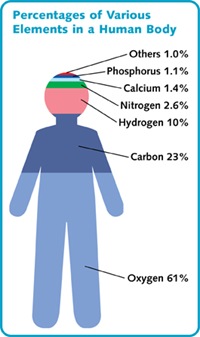 94 percent of the human body is made up of the key elements oxygen, carbon, and hydrogen. |
There is something like an ancient wisdom, encoded and tucked away in our DNA, that knows its point of origin as surely as a salmonid knows its creek.
Intellectually, we may not want to return there, but the genes know, and long for their origins—their home in the salty depths.
But if the seas are our immediate source, the penultimate source is certainly the heavens…
The spectacular truth is—and this is something that your DNA has known all along—the very atoms of your body—the iron, calcium, phosphorus, carbon, nitrogen, oxygen, and on and on—were initially forged in long-dead stars.
This is why, when you stand outside under a moonless, country sky, you feel some ineffable tugging at your innards. We are star stuff. Keep looking up.”
Posted by
Daron
at
11:10 AM
![]()
Labels: Albert Einstein, creativity, history, inventors, Maira Kalman, Nikola Tesla
“Lessons from General Grant,” by Francis Wilkinson, The Week, November 26, 2010:
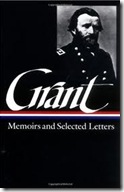 I'm a tragically slow reader, so I choose my books carefully. Lately, I've been reading the memoirs of U.S. Grant, albeit at a tortoise pace that makes my typical slow motion look like an Evelyn Wood demo. I've kept the book bedside for a couple years now, and still Appomattox is nowhere in sight. I move through chapters like heavy artillery through mud.
I'm a tragically slow reader, so I choose my books carefully. Lately, I've been reading the memoirs of U.S. Grant, albeit at a tortoise pace that makes my typical slow motion look like an Evelyn Wood demo. I've kept the book bedside for a couple years now, and still Appomattox is nowhere in sight. I move through chapters like heavy artillery through mud.
Yet the pace suits me — and the material. The war was a long, hard slog. And Grant's reflections have such resonance that I keep putting the book down to listen to the echoes. The fight against Mexico in 1846, Grant laments, was a "political" war waged on a false premise. Has a contemporary ring, doesn't it? The general who presided over the greatest destruction of American life in history — more than 600,000 soldiers on both sides died — also surprises with compassion. Contemptuous of slavery and committed to crushing the rebellion, Grant nonetheless has an ample soft spot for the enemy, taking risks to protect his foes' dignity. When Grant is ordered to handle rebels "without gloves" — including evicting Southern civilians from their homes and arresting them — he simply ignores the command. In fact, he fails to make a single arrest, having "deemed it better that a few guilty men should escape than that a great many innocent ones should suffer." It’s hard to resist projecting this thoughtful, anguished titan — a civil libertarian up to his epaulets in carnage — into the era of Guantánamo and Abu Ghraib. Grant didn't shrink from violence, but he didn't surrender principle, either. He did his duty, and he won. I peeked at the ending.
This Coldplay video was directed by Mat Whitecross and filmed in London on Thursday November 25th, 2010.
Excerpt from “Living as a River,” a Buddhist Geeks conversation with Bodhipaksa (October 11, 2010):
 “The brain has a limited capacity for bandwidth. Our short-term memory, for example, can only usually hold about 5-7 things. There’s not really that many things that we can pay attention to at one time. So, what happens when you’re meditating and just following your breath, is very often that a lot of thoughts are coming up and you start paying attention to those thoughts. And I found that, if you, as it were, choke the bandwidth of your mind by just paying a lot of attention to a lot of different stimuli at the same time, then you enter a state of a kind of open, expansive awareness, where there’s basically no room for thinking anymore. You’ve taken up all of your bandwidth. It’s a bit like there’s a bandwidth hog using your wireless internet connection, and everything’s going really slowly. That’s normally a bad thing, but here what we’re talking about going slowly is the discursive thinking that’s connected with stress and anxiety and irritability and wanting things. There’s no room for that anymore, so all we do is just notice our experience.”
“The brain has a limited capacity for bandwidth. Our short-term memory, for example, can only usually hold about 5-7 things. There’s not really that many things that we can pay attention to at one time. So, what happens when you’re meditating and just following your breath, is very often that a lot of thoughts are coming up and you start paying attention to those thoughts. And I found that, if you, as it were, choke the bandwidth of your mind by just paying a lot of attention to a lot of different stimuli at the same time, then you enter a state of a kind of open, expansive awareness, where there’s basically no room for thinking anymore. You’ve taken up all of your bandwidth. It’s a bit like there’s a bandwidth hog using your wireless internet connection, and everything’s going really slowly. That’s normally a bad thing, but here what we’re talking about going slowly is the discursive thinking that’s connected with stress and anxiety and irritability and wanting things. There’s no room for that anymore, so all we do is just notice our experience.”
![The History of England, From The Invasion of Julius Cæsar to the Revolution in 1688 by David Hume [Eight Volumes] The History of England, From The Invasion of Julius Cæsar to the Revolution in 1688 by David Hume [Eight Volumes]](http://lh6.ggpht.com/_khqAOpZqHEI/TPeanSfZOHI/AAAAAAAAENo/UJQjBt-aiN8/humes-england%5B6%5D.jpg?imgmax=800) “I have, in my place, books about English history. I like the bloodiness of it. I have one set of eight volumes. I read only the first volume, and of that only the first chapter, in which each time I see something else. But really, I am interested only in reading Volume Zero, which has not been written... History could not have started in the places they speak of. History preceded this; it just is not recorded. The beauty of architecture is that it deals with the recessions of the mind, from which comes that which is not yet said and not yet made.
“I have, in my place, books about English history. I like the bloodiness of it. I have one set of eight volumes. I read only the first volume, and of that only the first chapter, in which each time I see something else. But really, I am interested only in reading Volume Zero, which has not been written... History could not have started in the places they speak of. History preceded this; it just is not recorded. The beauty of architecture is that it deals with the recessions of the mind, from which comes that which is not yet said and not yet made.
Of all things, I honor beginnings. I believe, though, that what was has always been, and what is has always been, and what will be has always been. I do not think the circumstantial play from year to year, from era to era, has anything to do with what is available to you. The person of old had the same brilliance of mind that we assume we have now. But that which made a thing become manifest for the first time is our great moment of creative happening.”
~ Louis Kahn, from Louis I. Kahn: Writings, Lectures, Interviews

Daron Larson
Freelance Contemplative
